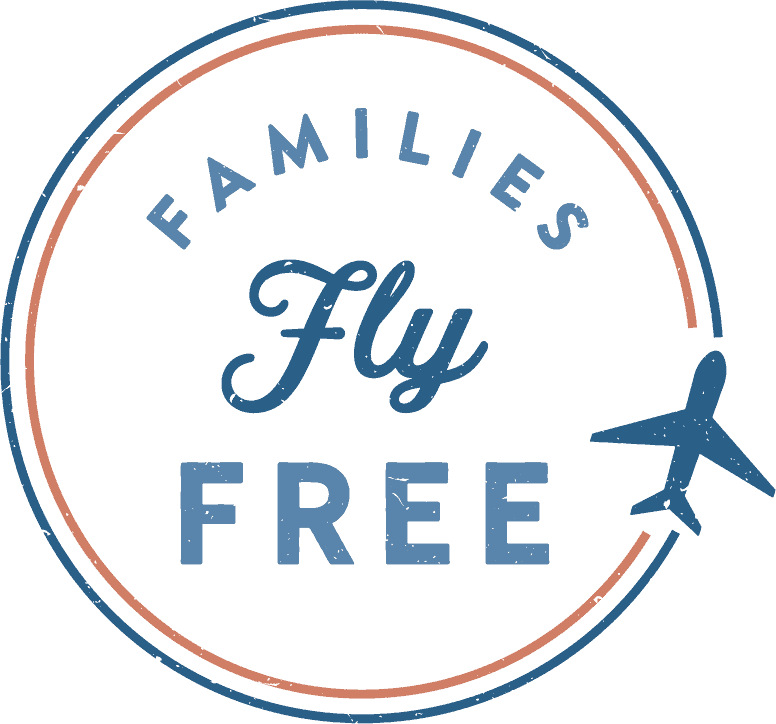When we began to plan posts on the National Parks, Rocky Mountain National Park was the most visited among the Families Fly Free team, and in fact, it is one of the most popular National Parks with more than three million people visiting every year.
We’ve compiled our collective wisdom and experience in this Ultimate Guide to Rocky Mountain National Park to help you on your next visit to this Colorado gem.

Want to learn the EASY way to fly for free by collecting and redeeming travel rewards? Join us in Families Fly Free, the premier online travel club where you can learn our SIMPLE, step-by-step system and save thousands of dollars in the process, while enjoying 1-on-1 support, a vibrant community and timely travel webinars and alerts. It's helped hundreds of families and thousands of people be able to travel MORE while spending less -- all while making priceless memories with their families.
The price of Families Fly Free, temporarily lowered in January 2024, is about to go back up, so there's no better time to join than NOW, the LOWEST price it's ever been available! We have limited slots left at this price and will increase the price once we reach capacity. Don't put off traveling with your family any longer. Tomorrow is not guaranteed.
See what members have to say...
Getting to Rocky Mountain National Park

Rocky Mountain National Park is one of the more accessible National Parks, as it’s located just west of Denver, a major city with an international airport.
Southwest Airlines flies into Rocky Mountain’s nearest airport, Denver International, though it is still a 2 hour drive away; however, how fun is it to hang out in Denver or even drive down to Colorado Springs for a few days before or after?!
[Read about Adventurous Things to Do in Colorado Springs for Families]
When you use your Southwest Companion Pass, so one person can fly free, and then use Southwest points to cover everyone else, you’ll have saved a whole lot of cash.
Driving in Rocky Mountain National Park
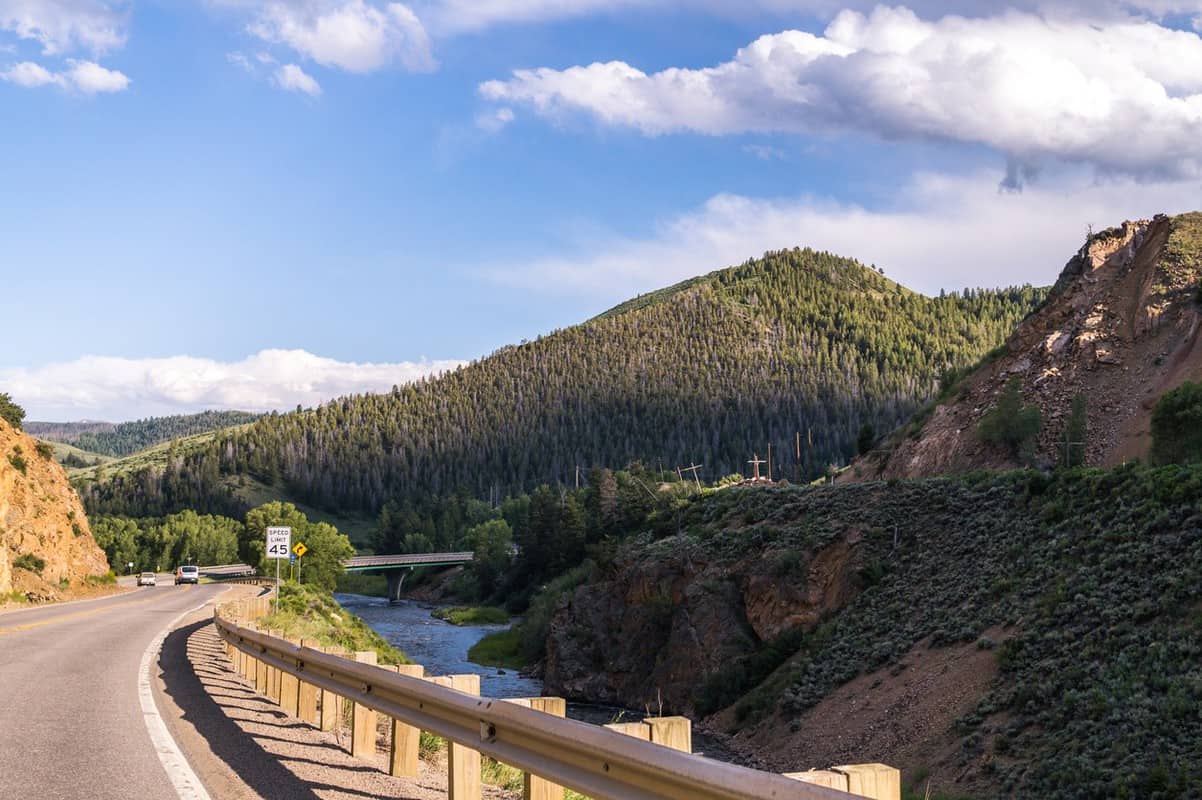
If you plan to drive through the park, allot most of your day for this activity. There are many points where traffic slows to a crawl, especially if wildlife is spotted by the side of the road!
Allow even more time if you want to hike inside the park, as the hike alone could take several hours depending on which one you choose. See our picks for best hikes in Rocky Mountain National Park below.
The most popular driving route is the 11-mile Trail Ridge Road, which is the highest continuously paved highway in North America. Another option is Bear Lake Road, which is 23 miles roundtrip to Bear Lake, one of the busiest areas of the park. There are also several hiking trails that start at this lake.
See this Rocky Mountain National Park map for driving directions along with some tips to help your car handle the steep inclines and declines.
NOTE: During certain months, you may be required to have a timed entry permit in order to enter the park by car unless you have a service reservation in the park such as camping, horseback riding or a commercial tour. They do hold some slots for last minute reservations which can be purchased the day before your planned entry. Create an account at recreation.gov and then check if a permit is needed and if so, reserve your permit HERE.
Parking is also likely to be a challenge during busier months, and you may not be able to find a parking spot at the key stops although it’s always worth a try. We’ve learned over the years that full (several spots still left) doesn’t necessarily mean full (no spots left)! So, if you’re willing to take a chance, go for it.

Not that daring? Park at the Estes Park Visitors Center and take the free shuttle into the park. This is ideal for hikers, as it drops you off close to your trailhead; no parking stress is required!
Note: Be sure the shuttle is currently running. It does not operate on the west side of the park, so check the map here first to make sure it goes where you need as well.
Entrance Fees

The park entrance fee is $35 per car and $30 per motorcycle for a 7-day pass.
Senior citizens can purchase a lifetime senior pass that covers ALL national parks for $80 or instead choose a $20 annual pass. The best part? Everyone in your car ALSO gets in with your senior pass. Nifty 😊…
Are you an active military member, veteran or Gold Star family? Grab a FREE pass and thank you for your service!
If you plan on visiting more than 2 National Parks in a year, opt for an America the Beautiful annual pass for $80 to save money.

And, don’t forget, if you have a fourth grader, your whole family gets into National Parks, as well as lands and waters, absolutely free during their school year and the following summer until August 31, as part of Every Kid Outdoors.
You can also access Rocky Mountain National Park FREE in 2024 on the below days, but keep in mind these days will be even MORE BUSY than usual:
| January 15 | Birthday of Martin Luther King, Jr. |
| April 20 | First day of National Park Week |
| June 19 | Juneteenth |
| August 4 | Great American Outdoors Act Anniversary |
| September 28 | National Public Lands Day |
| November 11 | Veterans Day |
Rocky Mountain National Park Weather
The weather in the mountains can change quickly. Be prepared for late afternoon thunderstorms in the summer and even hail in the spring or fall.
Also, snow stays around later and comes earlier than you might expect in other parts of the country. It snowed when we were there in early September, which boggled my mind since I was visiting from living in Dallas where it rarely snowed at all!
It’s also very often June before the snow melts (though you will still see snow at the higher elevations) and they’ve completely cleared the road to the top. You can check the current Rocky Mountain National Park weather conditions here.
Where to Stay

When visiting Rocky Mountain National Park, you have two main towns that are closest to the park: Estes Park and Grand Lake.
Estes Park is the busier and more popular of the two and accommodations will fill quickly in the summer and fall months. There are hotels, cabins, Vrbo rentals and campgrounds galore in Estes Park. You could stay near beautiful Lake Estes a little further away as well.
Besides that, there are stores, stores and more stores and many restaurants in downtown Estes. By whatever means necessary, try to have a meal at Bird and Jim. One of my traveling buddies said it was the best meal she’s ever had! So delicious.

The town of Grand Lake, with its beautiful mountain backdrop, provides many cabins and Vrbo vacation rentals and is situated on the west, less busy side of the park.
It’s so named for Grand Lake, which is Colorado’s largest natural lake. You can rent boats on the lake in the summer and snowmobile nearby in the winter. There’s shopping on the downtown boardwalk and be sure to have a meal at Pancho & Lefty’s, a popular Mexican restaurant, with a view of Grand Lake and patio seating in the summer.
Whichever side of the park you choose, making your reservations WAY in advance is ideal.
Rocky Mountain National Park Hotels
Here are two great hotels near Rocky Mountain National Park.
The Stanley, Estes Park

Remember “The Shining”? Author Stephen King was inspired to write the creepy novel about a hotel after a stay at The Stanley! But this is a classic grand hotel in a picturesque mountain setting, overlooking the park.
The property offers four different types of accommodations, including…
- the historic portion, which opened in 1909
- boutique-style rooms
- apartment-like suites
- private condo residences
Della Terra Mountain Chateau
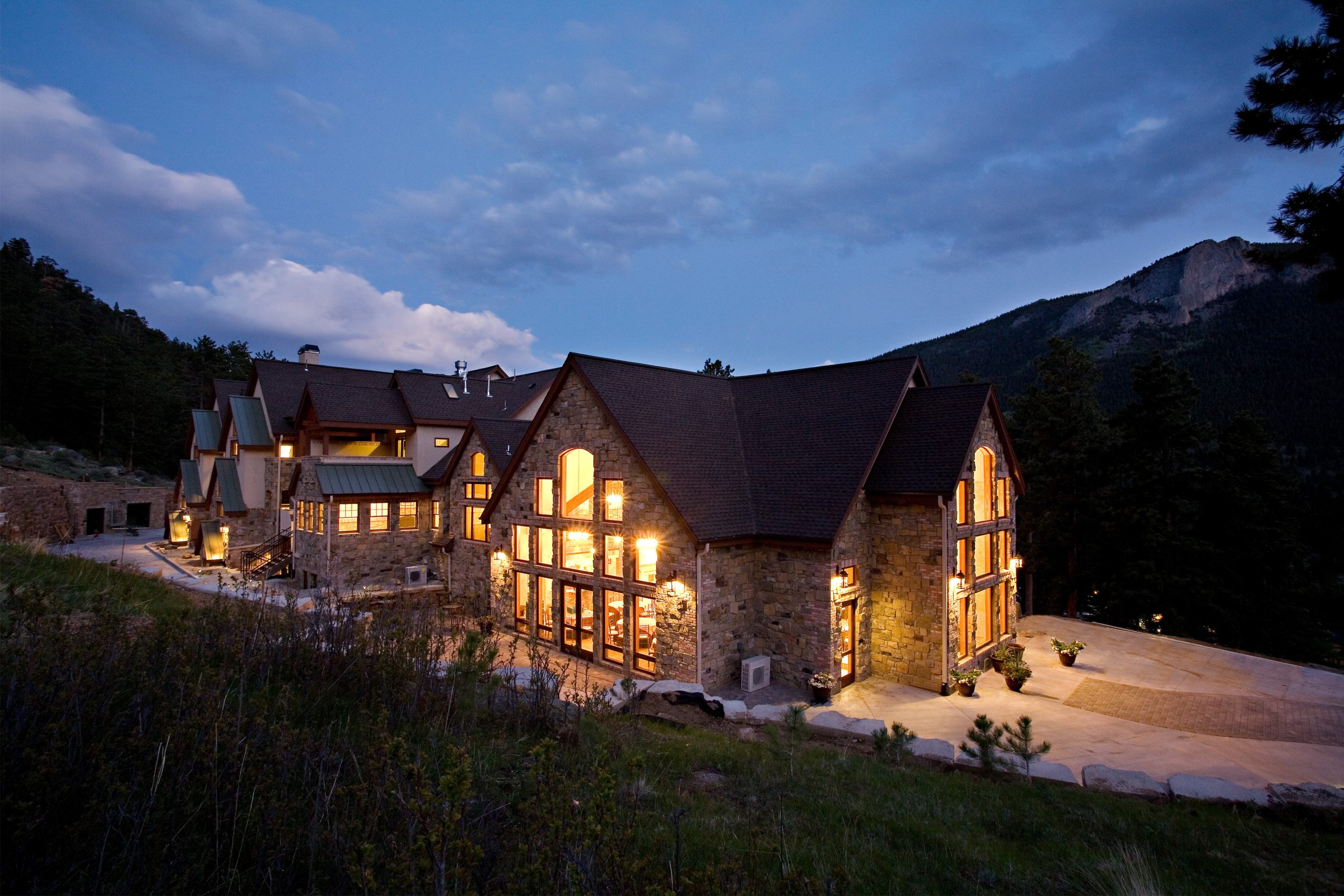
Located at the Fall River entrance to the park, the Della Terra Mountain Chateau is an upscale inn set on 14 acres. A family-owned property, the Chateau features a spa and a choice of a luxury suite or mountain cabin built in the early 1900s.
Rocky Mountain National Park Cabins and Camping
Here are some of our recommended Rocky Mountain National Park cabin and camping options.
YMCA of the Rockies

YMCA of the Rockies Estes Park offers cabins and lodges that sleep up to 10 guests and are very affordable. There are lots of activities for kids and families, such as:
- mini golf
- campfires
- challenge courses
- swimming
- roller skating
- crafts
You can also hike directly into the park from your cabin at the resort, so you can skip the whole “trying to find a parking spot” issue :).
[30 Brilliant Reasons to Book a Stay at YMCA of the Rockies]
See my video of a two-bedroom cabin at YMCA of the Rockies…
YMCA of the Rockies Snow Mountain Ranch in Granby offers cabins, lodges, camping and yurts for your family or a family reunion area for the whole crew.

They offer tons of activities including…
- cross country skiing
- horse-drawn sleigh rides
- dog sledding
- zip-lining
- fishing
- bike rentals
- summer tubing
So fun!
[34 Reasons to Visit YMCA of the Rockies Snow Mountain Ranch]
Check out my video of a two-bedroom cabin at YMCA of the Rockies Snow Mountain Ranch…
Jellystone Park
Jellystone Park, a family-friendly campground and resort with non-rustic “camping” and RV sites, is just 10 miles from Rocky Mountain National Park. They have a swimming pool, the popular candy bar bingo, theme nights and laser tag.

Park Campgrounds and Backcountry Camping
You can camp right inside the park, which is a great way to beat the crowds in the morning and be there after they leave in the evening. You can also choose campsites in the park’s backcountry, which is less crowded.
Campsites inside the park are $35 per night in summer and $30 per night in winter.
When to Visit the Park

Summer and fall are the busiest times in the park.
According to Estes-Park.com, the top 10 busiest days in the park from most busy to least busy were…
- September 24
- July 3
- September 4
- September 17
- July 24
- July 10
- July 17
- September 5
- July 23
- July 30
These dates also largely fall on weekends, so try to visit during the week if you can and better yet, arrive before 10 a.m. when parking tends to fill to capacity.
If you want to see mountain wildflowers, late spring and summer are the best times to catch the blooms.
Fall is a lovely time to visit, as it’s elk mating season, and you can often hear them making their characteristic “bugle” call throughout this time. It’s super cool to hear!
Mid-September is also when the aspen leaves turn gold, which is a bucket list site to see for sure! Just be prepared for snow!
Things to Do at Rocky Mountain National Park
Look for Wildlife
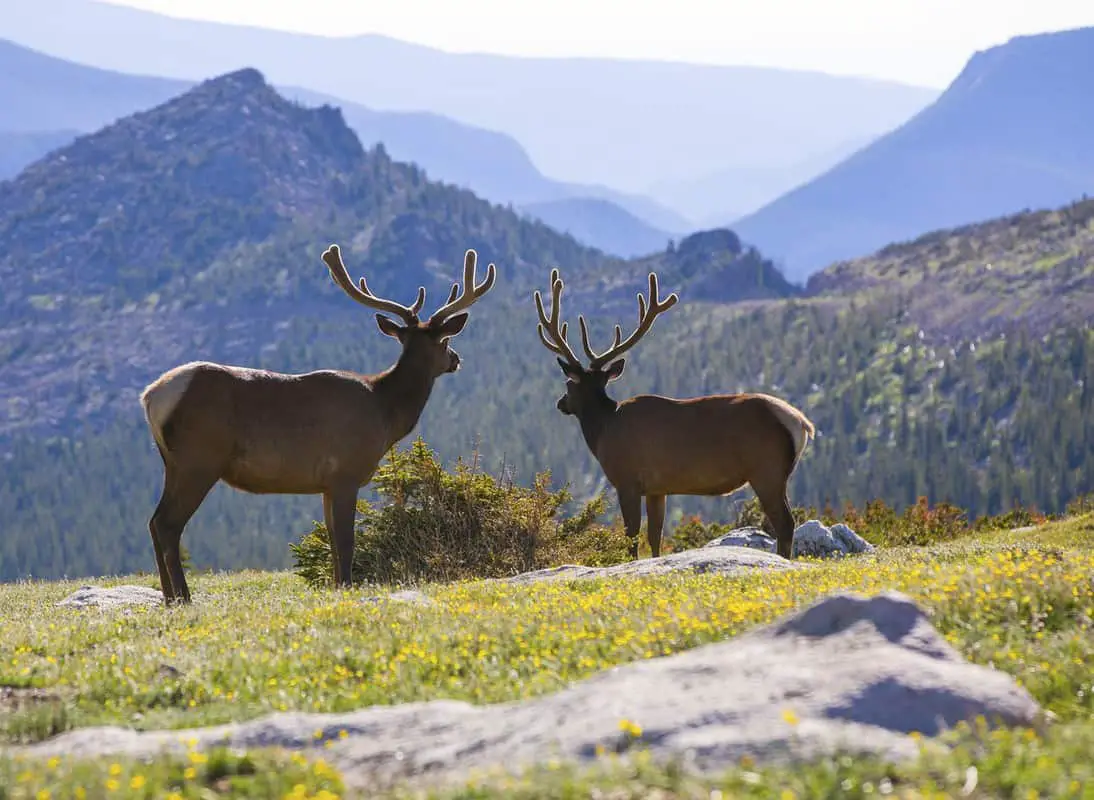
Spotting wildlife is a great activity inside Rocky Mountain National Park. Your best bets to see the creatures of the park are early morning or early evening.
Animals that live in the park range from mule deer and elk to smaller creatures like the super cute marmot often spotted sunning on rocks, as well as beavers and badgers. Moose, bear and mountain lion also call the park home.
If you enjoy birding, there are also plentiful birds, especially during the summer.
When Lyn visited with her family, they saw a large elk lounging by the side of the road, as well as big-horned sheep on the east side of the park. When I was there, I witnessed 2 elk sparring in the woods near my YMCA Estes Park cabin, which I got on video while standing safely behind a tree!
Go Fishing

If you like fly fishing, the confluence of the rivers in the YMCA Estes Park camp is the place to go with waders. My husband came face to face with three bull elk while fishing there. He was too scared to take a picture! 😲
See the Continental Divide
Colorado boasts more peaks that are higher than 14,000 feet than any other state, and Rocky Mountain has 60 mountains that are more than 12,000 feet, with its highest point an impressive 14,259 feet in elevation.
By comparison, the tallest peak in the continental U.S. is California’s Mt. Whitney, 14,505 feet, and the tallest mountain in the nation is Denali — also known as Mt. McKinley — in Alaska at a staggering 23,010 feet.
Take advantage of this park’s high altitude by visiting the Continental Divide, which runs north and south through the Park. You’re at what amounts to being on the top of a steep “roof” with water west of the Divide draining toward the Pacific Ocean with water to the east ultimately making its way to the Atlantic.
Climb Rocks
Rock climbing is a popular activity inside the park, especially during the summer and fall months.
Check out Lumpy Ridge with its granite walls and climbs with names like Batman and The Pear while more advanced rock climbers may want to head to Longs Peak at more than 14,000 feet in elevation.
Ride Horses
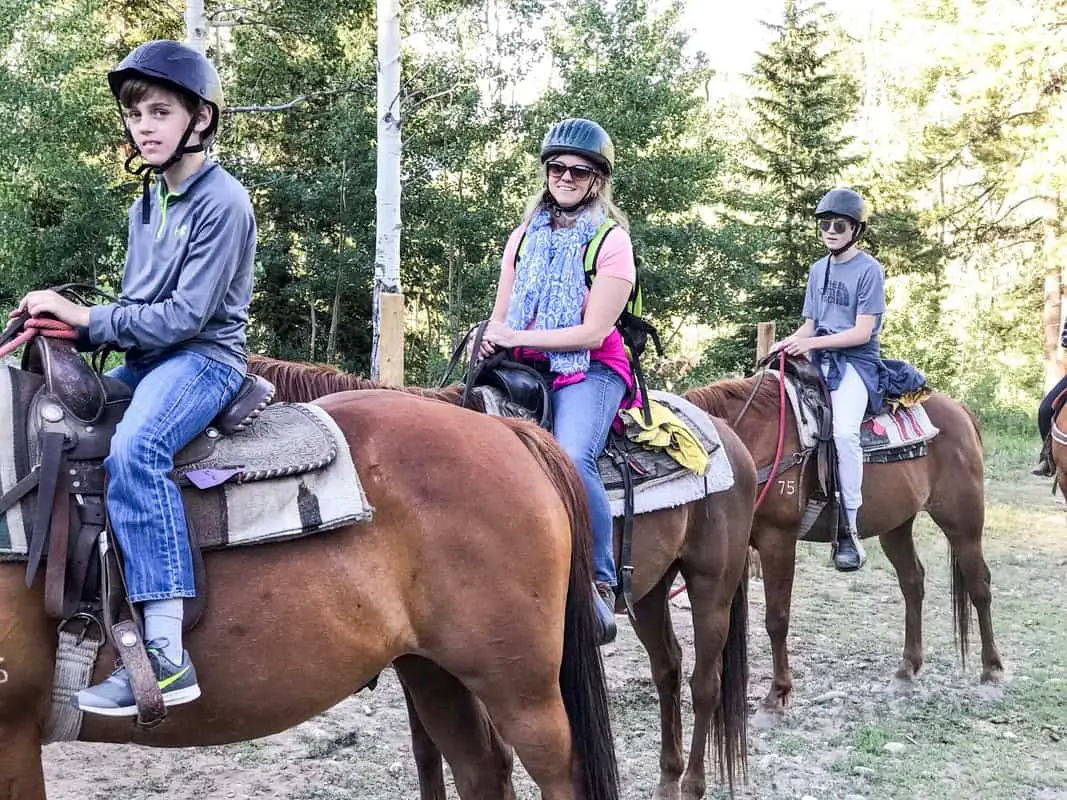
Riding horses, like Lyn and her boys show above, through the Rocky Mountains is a must-do. There’s nothing quite like letting a horse navigate you to your destination as you communicate with it through your body and the reins.
There are 260 miles of trails used for horseback riding inside the park, and there are many options for guided trail rides or a tour.
Top Rocky Mountain National Park Hikes
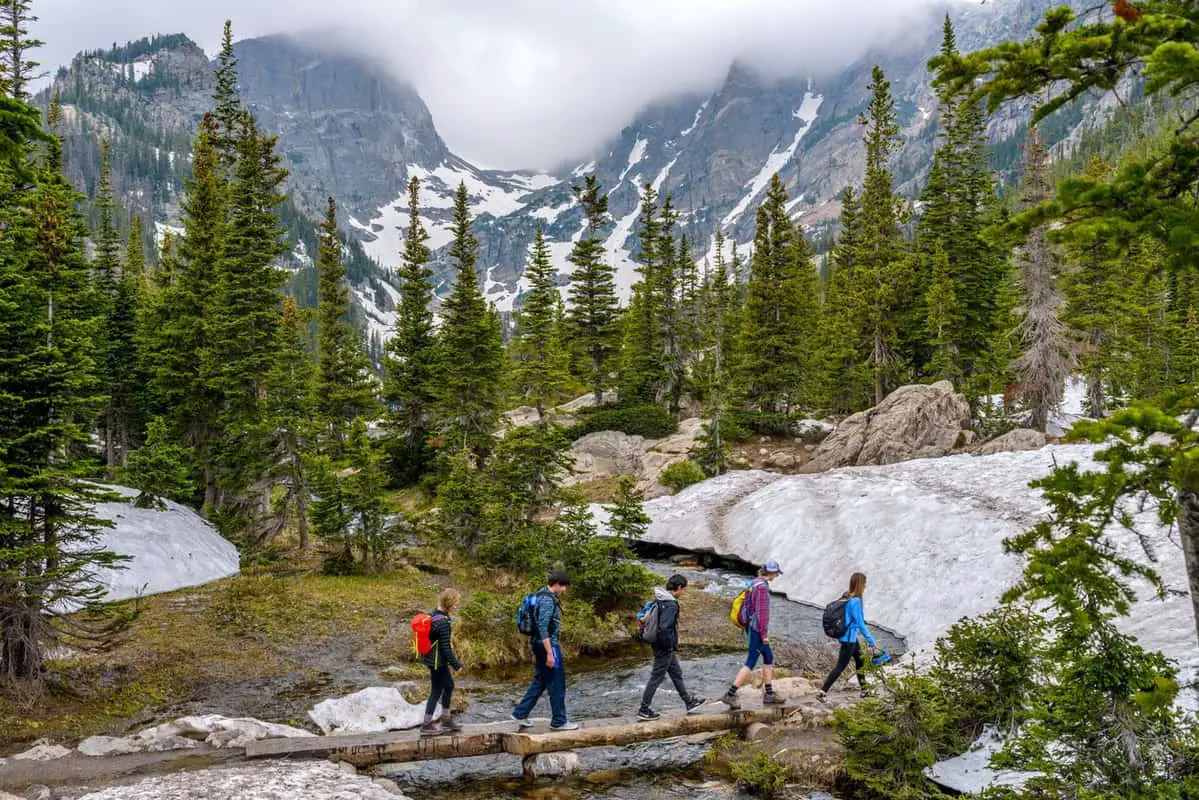
Here are some of the best hikes in Rocky Mountain National Park as recommended by the Families Fly Free team.
Find a complete list of Rocky Mountain National Park hikes here.
Bear Lake Loop

Because this is one of the most popular areas of the park, you’re unlikely to find a parking spot during the busy summer and fall months unless you get here SUPER EARLY! Therefore, the shuttle bus mentioned above may be your only option to access this area!
This is an easy .6-mile loop and nature trail great for families or those who aren’t looking to overly-exert themselves at the high elevation.
You can try what Lyn’s family does and head into the park far later in the day when most people are headed out for dinner. To do some of the hikes around Bear Lake, listed below, you’ll still have plenty of daylight left!
Nymph, Dream & Emerald Lakes
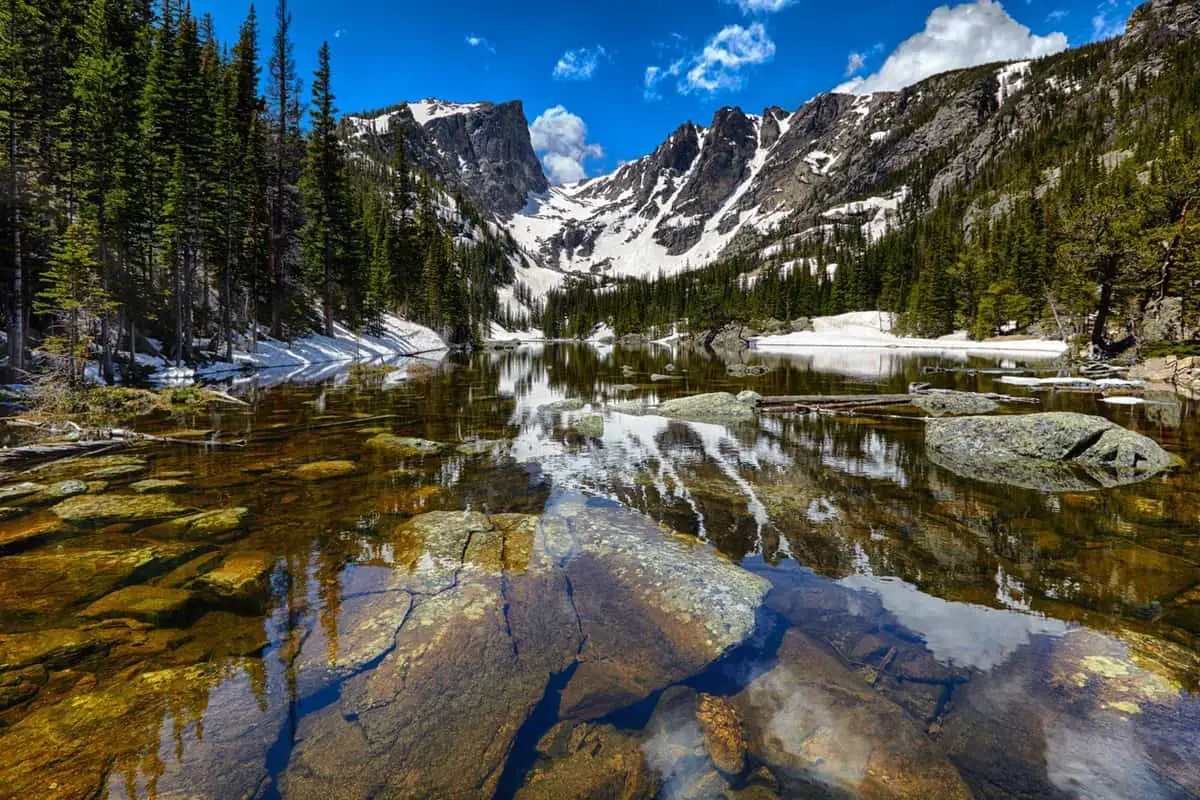
These hikes are some of the park’s most popular, because of their incredible views, but beware that during summer months they will be filled with people, as they too are accessed from the Bear Lake Trail Head.
Nymph Lake is the shortest at a mile round trip and Emerald Lake is the longest at about 4 miles round trip.
Dream Lake, just more than a 2-mile round trip hike, is one of my all-time favorite places on earth, as it’s absolutely gorgeous with perfectly clear water. My husband would recommend packing a fly rod to enjoy catch-and-release fishing. It can’t get much better than what is seen below!

Wild Basin Trailhead
From this trailhead, you can access many different hikes, including hikes to several different waterfalls and lakes. Choose from Copeland Falls, about .6 miles round trip, all the way to Lion Lake, a 14-mile hike round trip.
Timberline Falls
If you enjoy a reward at the end of your hike, choose a Rocky Mountain National Park hike that ends at a waterfall.
There are at least five options, including Timberline Falls. Located on the Eastside, this 4-mile hike gains about 1,500 feet in elevation. You might want to try acclimating first before you tackle this one!
Want more great Rocky Mountain hikes? Try this bucket list hike from Aspen to Crested Butte.
What to Bring to Rocky Mountain National Park

Layers of Clothing
The temperatures in Rocky Mountain National Park can vary wildly as you change elevation, so bring many different layers of clothes that you can add or remove.
Lyn also always recommends a poncho or rain-resistant light coat, as her family has been caught in an afternoon thunderstorm on a hike through the Rocky Mountains!
Water
The Rocky Mountains (and Denver, known as the “mile-high city”) sit at a higher elevation, which is both closer to the sun and drier. Some people even experience altitude sickness.
The cure for it all is water — and lots of it! Bring three times as much water as you think you might need! We’ve even started packing a water jug in our suitcase that we can leave in the car filled with ice and water to refill water bottles during the day.
Hiking Poles
The area’s high-altitude setting is a blessing, allowing beautiful, scenic views that are hard to beat. It’s also a curse: hiking up and down trails can be really tough on your knees.
You can buy (good ones are expensive) or rent hiking poles which, when used properly, will take pressure off your joints as you go uphill. They can also help you “catapult” onto the next step, rock or boulder.
Similarly, going downhill, which would appear to be less strenuous, can be just as tough or tougher. I’ve often found going downhill, if there are lots of rocks, takes me longer. Hiking poles can help here too, to arrest momentum going downhill and reduce the impact on your legs.
As an added bonus: Hiking poles require your arms and shoulders to do more work, which helps strengthen those muscles, which usually go unchallenged on trail hikes. I bet you didn’t know hiking could be a full-body workout!
Check out our post on 7 Top Tips for Visiting Our National Parks for more National Park tips.
Read More…
- What to Do With One Day at the Grand Canyon South Rim
- The Ultimate Guide to Zion National Park
- The Ultimate Guide to Bryce Canyon National Park
- The Ultimate Guide to Grand Teton National Park
- The Ultimate Guide to Yellowstone National Park
- Grand Canyon North Rim and South Rim: Your Ultimate Guide
Author
-

Cami Sauder, a member of the Families Travel Free team, is a longtime traveler who aims to be away from home at least 1/3 of the year. She's mastered the art of using miles and points to save on flights and hotels and saved more than $16,000 on travel using points in the last year. She and her husband have a goal to see as many National Parks as possible.
